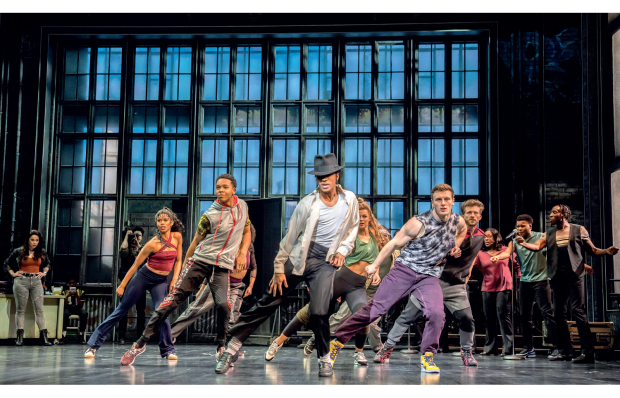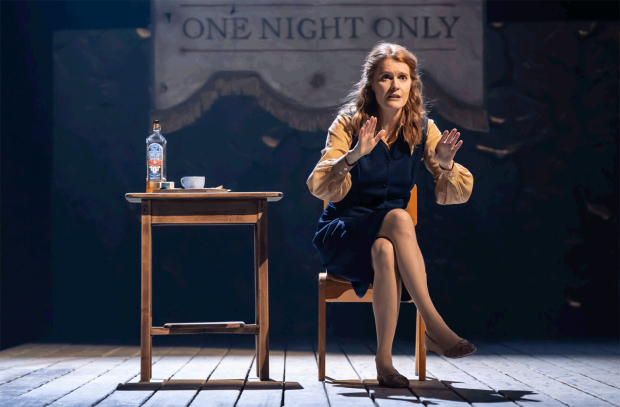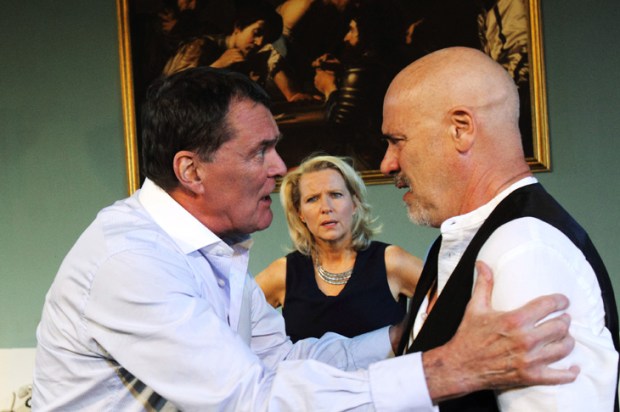Jamie Lloyd’s production of Pinter’s The Homecoming is a pile of terrific and silly ideas. Mostly terrific. The action takes place on a raised, thrusting stage surrounded by a steel canopy of scarlet rods like a boxing-ring. Ideal for a play about damaged men competing for a female trophy. Soutra Gilmour’s design is a model of sparse elegance. Centre stage, a worn green armchair like a waning tyrant’s throne. Stage right, a veneered sideboard that signals mass-produced chic. We’re in the 1960s so these pieces are from the previous decade. Well spotted, Ms Gilmour. Each scene is punctuated by racy music and strobe-y lights to remind us that this is a heightened, paranormal world. A perfect approach. If you run the play straight, as a seedy bit of Cockney soap, the non-sequiturs become too conspicuous. These are: Teddy and Ruth. What’s their motivation? Teddy has no reason to leave his three sons in America and bring his weird wife home to a family of insane misfits. Why surrender her without a fight? And why does she not prevent him?
Gary Kemp has worked hard to assume the mantle of the milk-toast philosopher Teddy. Kemp is a multimillionaire pop icon so he’s changed his accent and his body language and effaced his starry swagger to become a neurotic laundry basket, a mimsy, fretting, fatalistic eunuch. Virtuoso stuff. Ruth is fabulous too. Ruth, of course, is not a character but a primal goddess, a principle of nature, a slut-matriarch. Making her a readable human entity is a pointless exercise. Beautiful Gemma Chan plays her coolly, and correctly, as a polygonal sculpture swivelling methodically through her planes, steely, erotic, indomitable, promiscuous, menacing, never intelligible. Elderly Sam is usually portrayed as an impotent blur but Keith Allen, with lovely understatement, turns him into a closet queen (John Inman on a low heat), hinting at his sexuality beneath a prickly veneer of butch dignity. It’s the performance of the night. Or would be if it weren’t for John Simm as Lenny the pimp, a smiling shifty egoist, all smirks and twinkles and aggressive intelligence, a Blairite Cockney psycho. Prize-winning work.
Which brings us to the silly bits. Kemp and Chan (Teddy and Ruth) are required to ‘have a moment’ at the side of the stage to indicate inner turmoil. That’s not in the script. Best omitted. More silliness occurred in the audition room. OK, we understand the colour-blind casting thing but having a black actor playing the brother of two white actors is crazy in a play whose troubled heart flickers to the beat of unanswered paternity questions. And casting isn’t just about character and emotion. Physique counts. Ron Cook, as Max, fizzes like a cockerel with its tail on fire but he makes no sense opposite John Macmillan’s vast (and enjoyably stupid) Joey. When Max belts Joey in the six-pack, Joey snaps and crumples like a TV aerial in a hurricane. Yet Joey easily out-hulks Max. And he’s 25 to Max’s 70. If this were a real fight, Joey would laugh at Max’s puny punch, flex his shoulders a little, and rip Max to pieces before pushing him into the street via the letterbox. This is a powerful and three-quarters brilliant version of a hideous and sometimes rib-tickling script. It’s not an easy night out. Waves of hostility surged through the crowd at its more blatant passages of misogyny. Never mind. And by the way, fellas, take it easy. The awards will come.
The Arcola’s new play studies the life of rock-star psychiatrist R.D. Laing. Alan Cox, suave and charismatic, plays Laing like Marco Pierre White, a lyrical tyrant, an ungovernable messiah with Heseltine hair and a volcanic temper, leading his apostles towards some unknown paradise or inferno. Laing believed mental illness was a logical reaction to life’s insanity. Clinical interventions would therefore only damage a natural, beneficial process. He was truly a divided soul. He craved notoriety but also sought out the secluded mayhem of acid trips. When he necked pure LSD from a decanter his German partner complained, ‘I want to be with Ronnie Laing, not Henry VIII.’ His wardrobe was bipolar too. He favoured swirly James May shirts at home but preferred natty blue pinstripes on TV. To test his theories of mental illness he occupied Kingsley Hall in the East End where his patients lived on equal terms with their shrinks. Chaos ensued. Laing was quite happy treating uppity inmates to a dose of Glaswegian Largactil by head-butting them unconscious. Publicans nearby took exception to stray schizophrenics popping in and guzzling unattended pints. Rioting skinheads eventually attacked the building. Writer Patrick Marmion has created a bleakly hilarious account of an overlooked corner of hippy culture. Next stop for this script, TV.
Got something to add? Join the discussion and comment below.
Get 10 issues for just $10
Subscribe to The Spectator Australia today for the next 10 magazine issues, plus full online access, for just $10.














Comments
Don't miss out
Join the conversation with other Spectator Australia readers. Subscribe to leave a comment.
SUBSCRIBEAlready a subscriber? Log in